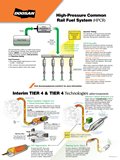Doosan reveals iT4 technology strategy
Winter 2012
In the Spring issue of DoMORE® magazine, significant editorial coverage was devoted to the history of clean air and air quality standards. A summary of the five air quality tiers was explained when each tier went into effect and the corresponding horsepower ranges. It ended with information about interim Tier 4 (iT4) and Tier 4 technology options available to non-road engine manufacturers.
This article will discuss the technologies that Doosan is implementing to comply with iT4 emission standards, as mandated by the Environmental Protection Agency (EPA). Additionally, Doosan is excited to announce a new family of articulated dump trucks (ADTs) and significant product updates to its excavators and wheel loaders.
Interim Tier 4
Doosan machines with engines of 75 horsepower or more are affected by iT4 regulations. This entails a continued reduction in nitrogen oxides (NOx) and particulate matter (PM). In order to meet the iT4 regulations, Doosan is utilizing several technologies for its excavators, wheel loaders and articulated dump trucks.
Excavators
Doosan crawler excavators and wheel excavators, from the DX140LC to the DX520LC, are affected by iT4 requirements and will incorporate a three-fold approach: Cooled Exhaust Gas Recirculation (CEGR), a Diesel Oxidation Catalyst (DOC) and a Diesel Particulate Filter (DPF). CEGR works well when the engine runs at a rated engine RPM versus varied engine RPMs. Since Doosan excavators typically operate at a full-rated RPM, the engine operates at a consistent combustion temperature and reduces NOx. The DOC and DPF act as after-treatments to reduce PM.
Wheel loaders
Like Doosan excavators, Doosan wheel loader models between DL200 and DL250 (75 to 175 hp) incorporate CEGR, a DOC and a DPF to meet iT4. Models DL300 through DL500 (175 to 300 hp) use Selective Catalyst Reduction to meet iT4, with Diesel Exhaust Fluid (DEF). Doosan DL300 and larger wheel loaders have increased engine torque; as much as 23 percent in some models.
Articulated dump trucks
Doosan articulated dump truck (ADT) engines will utilize SCR to meet iT4 emission regulations. A new family of Doosan ADTs has increased engine horsepower and torque.
Technology refresher
The technology applied to non-road diesel engines can be confusing to customers who are not familiar with the details. Thankfully, Doosan provides its customers with resources like this article, product literature and its website to help explain how the technologies help reduce harmful air toxins.
Cooled Exhaust Gas Recirculation
Cooled Exhaust Gas Recirculation works by recycling a portion of the exhaust gas with fresh air, thereby reducing oxygen levels in the combustion chamber. Lower oxygen levels result in lower combustion temperatures, reducing NOx emissions. A challenge with CEGR is that it creates more particulate matter and an after-treatment is needed. A diesel particulate filter collects the particulate matter that must be periodically removed via a regeneration process. This is accomplished by using heat to burn off the particulate matter, which combusts at a temperature of approximately 1100 F. Passive and active regeneration processes are utilized to burn off the accumulated particulate matter.
Engine oil
Doosan machines with the CEGR +DOC/DPF technologies will require the use of American Petroleum Institute (API) CJ-4 or low-ash oil. Low-ash oil reduces the amount of ash accumulated in the DPF, allowing you to meet the required service intervals. Oil additives protect emission control systems, reduce engine wear and minimize oil consumption.
Selective Catalyst Reduction
Selective Catalyst Reduction (SCR) reduces NOx using a liquid called Diesel Exhaust Fluid (DEF). DEF is water and ammonia. The combination of exhaust with DEF causes it to react with a catalyst. This reaction turns harmful NOx into harmless nitrogen and water vapor. Additionally, SCR systems offer increased fuel efficiency — as much as 16 percent — due to engine optimization that reduces particulate matter.
High-Pressure Common Rail
The High-Pressure Common Rail fuel (HPCR) delivery systems play an integral part in the emission reduction process. HPCR is an advanced fuel-injection system that regulates fuel pressure and injection timing, both crucial to improved engine efficiency. This system is used with Doosan excavators, wheel loaders and articulated dump trucks. Read about this online at www.DoosanEquipment.com.
Fuel injectors used on Doosan excavators, wheel loaders and articulated dump trucks are controlled by the electronic control unit to deliver fuel to the combustion chamber at the appropriate time, contributing to a quieter machine and more power.
 English
English



